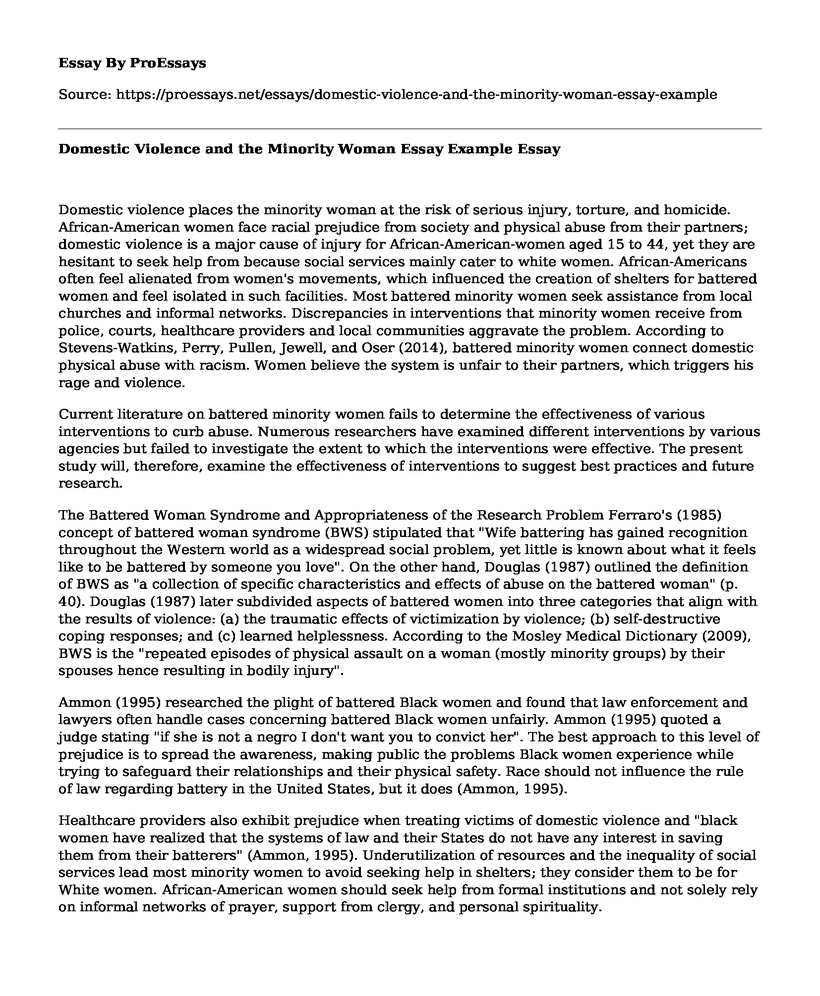Domestic violence places the minority woman at the risk of serious injury, torture, and homicide. African-American women face racial prejudice from society and physical abuse from their partners; domestic violence is a major cause of injury for African-American-women aged 15 to 44, yet they are hesitant to seek help from because social services mainly cater to white women. African-Americans often feel alienated from women's movements, which influenced the creation of shelters for battered women and feel isolated in such facilities. Most battered minority women seek assistance from local churches and informal networks. Discrepancies in interventions that minority women receive from police, courts, healthcare providers and local communities aggravate the problem. According to Stevens-Watkins, Perry, Pullen, Jewell, and Oser (2014), battered minority women connect domestic physical abuse with racism. Women believe the system is unfair to their partners, which triggers his rage and violence.
Current literature on battered minority women fails to determine the effectiveness of various interventions to curb abuse. Numerous researchers have examined different interventions by various agencies but failed to investigate the extent to which the interventions were effective. The present study will, therefore, examine the effectiveness of interventions to suggest best practices and future research.
The Battered Woman Syndrome and Appropriateness of the Research Problem Ferraro's (1985) concept of battered woman syndrome (BWS) stipulated that "Wife battering has gained recognition throughout the Western world as a widespread social problem, yet little is known about what it feels like to be battered by someone you love". On the other hand, Douglas (1987) outlined the definition of BWS as "a collection of specific characteristics and effects of abuse on the battered woman" (p. 40). Douglas (1987) later subdivided aspects of battered women into three categories that align with the results of violence: (a) the traumatic effects of victimization by violence; (b) self-destructive coping responses; and (c) learned helplessness. According to the Mosley Medical Dictionary (2009), BWS is the "repeated episodes of physical assault on a woman (mostly minority groups) by their spouses hence resulting in bodily injury".
Ammon (1995) researched the plight of battered Black women and found that law enforcement and lawyers often handle cases concerning battered Black women unfairly. Ammon (1995) quoted a judge stating "if she is not a negro I don't want you to convict her". The best approach to this level of prejudice is to spread the awareness, making public the problems Black women experience while trying to safeguard their relationships and their physical safety. Race should not influence the rule of law regarding battery in the United States, but it does (Ammon, 1995).
Healthcare providers also exhibit prejudice when treating victims of domestic violence and "black women have realized that the systems of law and their States do not have any interest in saving them from their batterers" (Ammon, 1995). Underutilization of resources and the inequality of social services lead most minority women to avoid seeking help in shelters; they consider them to be for White women. African-American women should seek help from formal institutions and not solely rely on informal networks of prayer, support from clergy, and personal spirituality.
References
Ammons, L. (2018). The Plight of Black Battered Women. Retrieved from https://academic.udayton.edu/health/01status/violence04.htmDutton, D. G., & Painter, S. (1993). The battered woman syndrome: Effects of severity and intermittency of abuse. American Journal of Orthopsychiatry, 63(4), 614-622.
http://dx.doi.org/10.1037/h0079474Ferraro, J. and Basile, L. (1985). Fourier transform infrared spectroscopy. Academic.Mosby, Inc. (2013). Mosby's dictionary of medicine, nursing & health professions. St. Louis, Mo: Elsevier/Mosby.
Stevens-Watkins, D., Perry, B., Pullen, E., Jewell, J., & Oser, C. B. (2014). Examining the associations of racism, sexism, and stressful life events on psychological distress among African-American women. Cultural Diversity and Ethnic Minority Psychology, 20(4), 561-569.
Cite this page
Domestic Violence and the Minority Woman Essay Example. (2022, Jul 08). Retrieved from https://proessays.net/essays/domestic-violence-and-the-minority-woman-essay-example
If you are the original author of this essay and no longer wish to have it published on the ProEssays website, please click below to request its removal:
- Paper Example on Divorce in Sharia Law
- Research Proposal on the Necessity of Parental Involvement in the Education Life of a Child
- Paper Example on Canadian Inequality
- Children of Divorce Are Delayed in Many Aspects: Research Paper
- How Does the Traditional or Cultural Belief Influence the Prevalence of Mental Health in Individuals
- Essay Sample on Effective Communication Skills: An Essential Requirement for Job Interviews
- Paper Example: Organizational Profit Target: Ethical Considerations & Quality Services







